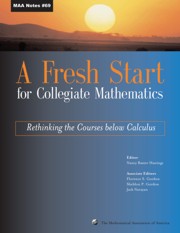Book contents
- Frontmatter
- Preface
- Contents
- Introduction
- Background
- Theme 1 New Visions for Introductory Collegiate Mathematics
- Theme 2 The Transition from High School to College
- Theme 3 The Needs of Other Disciplines
- Theme 4 Student Learning and Research
- Theme 5 Implementation
- Theme 6 Influencing the Mathematics Community
- Ideas and Projects that Work: Part 1
- Ideas and Projects that Work: Part 2
- 35 Mathematics in Action: Empowering Students with Introductory and Intermediate College Mathematics
- 36 Precalculus: Concepts in Context
- 37 Rethinking College Algebra
- 38 From The Bottom Up
- 39 The Functioning in the Real World Project
- 40 The Importance of a Story Line: Functions as Models of Change
- 41 Using a Guided-Inquiry Approach to Enhance Student Learning in Precalculus
- 42 Maricopa Mathematics
- 43 College Algebra/Quantitative Reasoning at the University of Massachusetts, Boston
- 44 Developmental Algebra: The First Mathematics Course for Many College Students
- 45 Workshop Precalculus: Functions, Data, and Models
- 46 Contemporary College Algebra
- 47 Precalculus: A Study of Functions and Their Applications,
- 48 Success and Failures of a Precalculus Reform Project
39 - The Functioning in the Real World Project
from Ideas and Projects that Work: Part 2
- Frontmatter
- Preface
- Contents
- Introduction
- Background
- Theme 1 New Visions for Introductory Collegiate Mathematics
- Theme 2 The Transition from High School to College
- Theme 3 The Needs of Other Disciplines
- Theme 4 Student Learning and Research
- Theme 5 Implementation
- Theme 6 Influencing the Mathematics Community
- Ideas and Projects that Work: Part 1
- Ideas and Projects that Work: Part 2
- 35 Mathematics in Action: Empowering Students with Introductory and Intermediate College Mathematics
- 36 Precalculus: Concepts in Context
- 37 Rethinking College Algebra
- 38 From The Bottom Up
- 39 The Functioning in the Real World Project
- 40 The Importance of a Story Line: Functions as Models of Change
- 41 Using a Guided-Inquiry Approach to Enhance Student Learning in Precalculus
- 42 Maricopa Mathematics
- 43 College Algebra/Quantitative Reasoning at the University of Massachusetts, Boston
- 44 Developmental Algebra: The First Mathematics Course for Many College Students
- 45 Workshop Precalculus: Functions, Data, and Models
- 46 Contemporary College Algebra
- 47 Precalculus: A Study of Functions and Their Applications,
- 48 Success and Failures of a Precalculus Reform Project
Summary
The calculus reform movement of the last decade or more has led to major changes that include an emphasis on geometric and numerical ideas as a balance to symbolic manipulations, student projects, realistic applications via mathematical modeling, the use of technology, and a more active learning environment. These efforts were intended to transform calculus into a pump, not a filter.
But if we are to change calculus, we must also consider how we “fill the tank”; that is,
how do we increase the numbers of students who proceed on to calculus?
how do we improve the mathematical experience of both those students and the ones who have no intention of going on to calculus?
Each year approximately three-quarters of a million college students take some variety of precalculus course; yet only a small fraction of them ever go on to start calculus. Most of those who do take calculus display a singular lack of retention of the material they were taught and often cannot complete calculus. This is a dreadful indictment of the effectiveness of traditional precalculus courses. They neither motivate the students to go on in mathematics nor adequately prepare them when they do continue, especially in view of the changing curricula in calculus and also the client disciplines.
- Type
- Chapter
- Information
- A Fresh Start for Collegiate MathematicsRethinking the Courses below Calculus, pp. 348 - 351Publisher: Mathematical Association of AmericaPrint publication year: 2006

